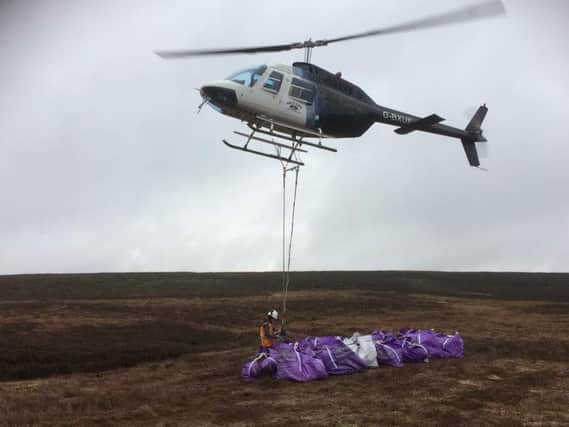VIDEO: Helicopters fly in to improve North Yorkshire moor


The rocks have been used to create small dams on Colsterdale Moor near Masham which will protect the underground water table and nationally important peatland moss that grows on top of it.
Across England, peatland plays a vital environmental role by storing more than 3bn tonnes of carbon in the ground - more than all woodlands and forests combined.
Advertisement
Hide AdAdvertisement
Hide AdBy protecting and planting more peatland mosses on the Moor, Yorkshire Water and the Yorkshire Peat Partnership aim to reduce soil erosion. By doing so, drinking water collected by Yorkshire Water will have less sediment in it before it is treated.
Andrew Walker, catchment strategy manager at Yorkshire Water, said: “We believe that wetter is better and the dams that we’ve created with the sandstone will crucially improve the moisture levels on Colsterdale Moor.
“This has so many benefits beyond just improving drinking water as wetter ground may also offer natural flood management benefits and helps lock carbon in the land rather than it getting into the atmosphere or our reservoirs.”
Historically, government policy led to much of the peatland in England being drained to improve land for livestock grazing. More recent policy also encouraged more heather growth on the peatlands which provided cover and food for grouse.
Advertisement
Hide AdAdvertisement
Hide AdYorkshire Water’s project on Colsterdale Moor is part of a wider scheme to make the region’s uplands more diverse, through cutting and removing areas of heather and introducing peat forming mosses to try and make the moors wetter.
Mr Walker added: “Inappropriate management of heather on deep peat can cause the peat to degrade and erode, but also washes tonnes of sediment nto our reservoirs which can impact on the colour of water and requires intensive water treatment to remove.”
By reducing the amount of sediment in the local reservoirs, the project will improve the quality of water captured on the moor which is treated at two nearby water treatment works.
Matt Cross, from the Yorkshire Peat Partnership, said: “We are cutting large areas of heather on Masham Colsterdale to inoculate with sphagnum which will help re-wet the peat and maintain the water table. The cut heather brash isn’t going to waste though, it’s being flown to another moor, Stean, and used as a mulch to help revegetate areas of bare and eroding peat. This will reduce the amount of sediment running of the moor and into Gouthwaite
reservoir.”
Advertisement
Hide AdAdvertisement
Hide AdOver the next four years Yorkshire Water has committed to conserving and enhancing 43 sq miles of Yorkshire’s peat moorland, much of which it owns and is designated as a Site of Special Scientific Interest.